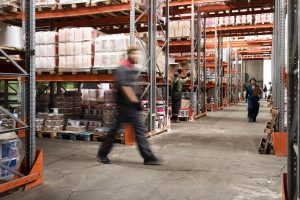The last decade has brought a lot of innovation into warehouse operations, targeted at making it faster, more efficient and less error-prone. While historically most warehouses have relied heavily on human labor for the picking and placing of items, most warehouses today adopt some level of goods-to-person (GTP) automation. By bringing goods directly to pickers, rather than having them travel to the goods, these systems significantly reduced the time and physical strain involved in the picking process.
GTP systems fall into two general categories:
- Early iterations of GTP technology focused on mechanized solutions like conveyor belts and static picking stations, which already marked a considerable improvement in efficiency and accuracy over manual methods. In addition, horizontal/vertical carousels and vertical lift modules (VLMs) were used to present items to pickers.
- Currently, random access, high-density systems, including cube and shuttle-based systems, are used to deliver items to a picker at a pick station.
This article focuses on GTP systems of the second category, which truly revolutionized GTP systems by integrating advanced technologies such as robotics, artificial intelligence and machine learning.
How A GTP System Works
When an order management system picks up an order for fulfillment through the GTP system, the following key steps are involved:
- SKU identification: Identifying the SKUs that one or more of the orders require for fulfillment. This could involve batching or waving orders together to orchestrate the fulfillment in the most efficient manner.
- Storage location identification: In a GTP system, SKUs are densely stored in three-dimensional storage racks. Storage locations of each SKU is mapped in the database and serve as a reference for the source location at which the robot is assigned a task. Based on the SKUs to be retrieved, this list of tasks from appropriate storage locations is generated.
- Robot task assignment and management: The GTP system considers robot availability and proximity to allocate and manage the task of moving the SKU from the identified storage location to the pick station.
- Presentation of totes at the pick station: The picker is presented with one or more SKUs based on the requirement at the pick station and is prompted to pick an appropriate quantity of different SKUs to fulfill the order(s).
Benefits Of A GTP system
Efficiency And Throughput
An efficient GTP system ensures that SKUs are presented ergonomically with sufficiently high throughput for optimal picker efficiency. High throughput rates are crucial for optimizing picker efficiency in warehouses due to several key factors.
- High throughput minimizes the idle time between picks, ensuring that pickers are consistently engaged in productive tasks, which increases picker efficiency.
- High throughput ensures that pickers can quickly access and process a large number of diverse orders, reducing the time from order receipt to dispatch. This directly translates to increased order fulfillment and customer satisfaction.
- When space is limited and inventory turnover is high, as in the cases of distributed warehouses and back-of-store fulfillment, efficient throughput enables effective utilization of space for both retail and fulfillment purposes.
Better Predictability Of Operations And Customer Satisfaction
GTP systems typically result in more precise picking, reducing errors and enhancing overall quality control in order fulfillment.
- GTP systems organize and streamline picking processes, making the operations more predictable. By consistently delivering items to pickers, these systems reduce variability in picking times and increase the reliability of order processing.
- GTP systems often integrate sophisticated software for inventory tracking and management. This technology provides real-time visibility into inventory levels, allowing for more accurate forecasting and replenishment. Better inventory management ensures that products are available when needed, reducing the chances of stockouts and back orders, which are common pain points for customer dissatisfaction.
- The efficiency of GTP systems enables quicker processing of orders from receipt to dispatch. Faster order processing leads to shorter delivery times, a key factor in customer satisfaction, especially in today’s market where consumers expect rapid delivery.
- The precision of GTP systems in picking and handling items significantly reduces the error rate in orders.
- GTP systems can easily scale to handle increased order volumes, such as during peak seasons, without a significant drop in efficiency. This scalability ensures that the warehouse can maintain consistent service levels even during busy periods, which is crucial for maintaining customer trust and satisfaction.
By accelerating the picking process and providing predictable fulfillment, GTP systems lead to improved customer service, driving customer satisfaction and repeat business.
Better Work Conditions And Skill Enhancement For Pickers
- GTP systems significantly decrease the physical burden on pickers by handling heavy lifting and extensive walking, leading to less fatigue and lower risk of musculoskeletal injuries.
- Automated systems often create a more organized and predictable working environment, with controlled temperatures and reduced noise levels, making the workspace more comfortable for pickers.
- Automation provides pickers with opportunities to learn new skills such as operating automated systems, monitoring software and managing technology-driven processes, thus enhancing their career prospects.
Challenges With A GTP system
While GTP systems offer significant operational benefits, there are some challenges to keep in mind:
- There are GTP solutions based on different technologies; the selection of a suitable system can be difficult.
- Sizing and selecting a system may need a vision of how the GTP solution will scale with business growth.
- Interface needs with upstream and downstream automation systems need evaluation and planning.
How GTP Systems Are Evolving
In essence, GTP automation is a symphony of technology and human expertise. It combines the speed and efficiency of robots with the accuracy and adaptability of human operators. While these are driving adoption of GTP systems, choosing and deploying a GTP system needs evaluation and careful selection. A well-deployed GTP system results in warehouse operations becoming faster, more accurate and more efficient.





